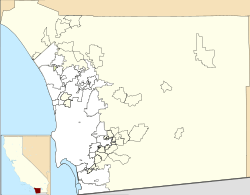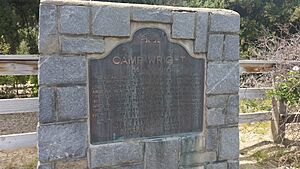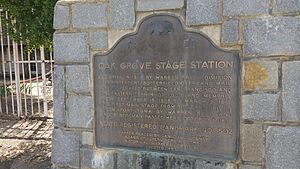Oak Grove Butterfield Stage Station facts for kids
|
Oak Grove Butterfield Stage Station
|
|

Oak Grove Butterfield Stage Station
|
|
| Location | Warner Springs area, San Diego County, California |
|---|---|
| Built | 1858 |
| NRHP reference No. | 66000222 |
Quick facts for kids Significant dates |
|
| Added to NRHP | October 15, 1966 |
| Designated NHL | November 5, 1961 |
The Oak Grove Butterfield Stage Station is a historic building in northern San Diego County, California. It is found in the western foothills of the Laguna Mountains. This station is located on State Route 79, about 13 miles (21 km) northwest of Warner Springs. It was built in 1858 and is the only remaining station from the famous Butterfield Overland Mail stagecoach line in the Western United States.
The station is also special because it sits on the former site of Camp Wright. This was an important military outpost during the American Civil War in the 1860s.
Contents
Camp Wright: A Civil War Outpost
During the American Civil War, Camp Wright was a military base for the Union Army. The Union Army was the army of the northern states that wanted to keep the United States together. This camp was set up to protect a travel route to Fort Yuma on the Colorado River. It also aimed to stop people who supported the southern states (the Confederate Army) from traveling east to join their forces.
A group of soldiers called the California Volunteers first set up Camp Wright in October 1861. They chose a spot near Warner's Ranch. However, the weather there was very cold and windy. So, in November, the commander moved the camp to the more sheltered Oak Grove location.
Stopping Secessionists
Around the same time, a group led by Daniel Showalter was trying to sneak across the desert. They wanted to join the Confederate Army in Texas. Soldiers from Camp Wright chased them from Temecula. With help from other troops, they caught Showalter's group in the hills west of the San Jose Valley. No shots were fired, and the group was captured between November 20 and 29, 1861.
After being held at Fort Yuma, Showalter and his group were set free. They had to promise loyalty to the Union. However, they later made their way to the Confederacy.
For a short time in March 1862, Camp Wright was the main base for the 5th Regiment California Volunteer Infantry. After that, it was used as a stopping point for troops traveling to and from New Mexico Territory and Arizona Territory. The camp was finally closed in 1866.
The Butterfield Stage Station
The Oak Grove Butterfield Stage Station operated between 1858 and 1860. It was a vital stop on the San Francisco to St. Louis route. This route was a long stagecoach line that delivered mail and passengers across the country.
The building itself is a well-preserved, one-story adobe structure. Adobe is a type of building material made from earth and organic materials. It is located among beautiful California oak woodlands.
Historic Landmarks
Both the site of Camp Wright and the Oak Grove Butterfield Stage Station are recognized as important historical places.
The site where Camp Wright once stood was named a California Historical Landmark in 1950. A California Historical Landmark is a place, building, or event that has special historical importance to the state of California.
The Oak Grove Butterfield Stage Station building itself was named a separate California Historical Landmark in 1952. Later, in 1961, the Oak Grove station was also declared a National Historic Landmark. A National Historic Landmark is a site, building, structure, object, or district that is officially recognized by the U.S. government for its outstanding historical importance to the nation. Another nearby station at Warner's Ranch is also a National Historic Landmark.
See also
 In Spanish: Oak Grove Butterfield Stage Station para niños
In Spanish: Oak Grove Butterfield Stage Station para niños






